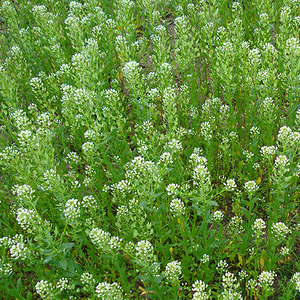Researchers to use DOE grant to help strengthen pennycress genes

Photo: USDA-ARS
August 10, 2020
BY The Donald Danforth Plant Science Center
The U.S. DOE awarded a five-year, $13 million grant to a nationwide research project to genetically strengthen Thlaspi arvense, commonly known as pennycress, for use in sustainable energy efforts. A relative of canola, pennycress produces oilseed for food, animal feed and bioenergy. Some domesticated pennycress varieties can yield more than 1,500 pounds per acre of seeds, producing the potential for 65 gallons of oil per acre that can be converted into biodiesel and bio jet fuel. In addition to its use as a biofuel, pennycress provides ground cover to reduce soil erosion and can absorb excess fertilizer to prevent pollution.
Pennycress is ideally positioned as both a cash and cover crop that can be planted over winter between rotations of corn and soybeans. It can provide ecosystem services, such as reducing soil erosion and soaking up excess nitrogen fertilizer that otherwise pollutes our waterways—and it produces a valuable, high-quality oilseed—growing at a time when farmland is often bare. But many of the hardy traits that make it an effective weed adapted to many different environments need to be harnessed into a package that works for farmers and management of their main crops. The research team aims to accelerate that process using broad expertise and cutting-edge technology.
Together, Dmitri A. Nusinow and Chris Topp, principal investigators at the Danforth Center, aim to increase pennycress’ tolerance to heat and drought through combining gene editing and traditional plant breeding techniques. They will focus on understanding and improving root-system structure and function of pennycress, using X-ray CT imaging and a novel system developed in the Topp lab to grow and measure plants in field plot-sized containers outfitted with sensors in the greenhouse.
Advertisement
“One of the lessons we learned from the Green Revolution was that not enough attention was paid to root systems as new varieties were developed, resulting in a number of negative environmental consequences,” Topp said. “Here we get the opportunity to build a new crop from the ‘underground up,’ which should improve agricultural sustainability, soil health, and turn a profit for growers in the biobased fuels market.”
“It is really exciting to work on the early domestication of a new crop, especially one that can help our energy needs, increase farmland productivity, and decrease topsoil loss and pollution,” Nusinow said. “We will apply new gene-editing methods and leverage the knowledge from pennycress’ close relative and research workhorse, Arabidopsis thaliana, to potentially make quick progress and big gains. The national scope of the project will bring a lot of great ideas together.”
Advertisement
The DOE project is led by Illinois State University Professor of Genetics John Sedbrook who has been working for decades in the field and devoted years to domestication and improvement of the seed oil and protein from pennycress.
“We’re excited to be at the forefront of this collaboration involving top scientists from universities and labs around the country and the world,” said Sedbrook, whose lab at Illinois State works to bring out positive genetic traits in plants for biofuel and bioenergy production while protecting the environment.
Other institutions taking part in the project include the Carnegie Institution for Science, the University of Minnesota, the DOE Oak Ridge National Laboratory, the DOE Pacific Northwest National Laboratory EMSL, Western Illinois University, Washington State University and The Ohio State University.
Founded in 1998, the Donald Danforth Plant Science Center is a not-for-profit research institute with a mission to improve the human condition through plant science. Research, education and outreach aim to have impact at the nexus of food security and the environment and position the St. Louis region as a world center for plant science. The center’s work is funded through competitive grants from many sources, including the National Institutes of Health, DOE, National Science Foundation, and the Bill & Melinda Gates Foundation.
Related Stories
At the University of Missouri, plant biochemist Jay Thelen is using arabidopsis as a powerful model to explore ways to boost oil production — an important step toward creating more sustainable, plant-based energy sources.
Iowa farmers have a new market opportunity for their 2025 soybean crop. Landus is expanding its Clean Fuel Regulation initiative, made possible by recent policy changes expected to increase Canada's demand for liquid biofuel.
Total U.S. operable biofuels production capacity expanded in May, with gains for renewable diesel and a small decrease for ethanol, according to data released by the U.S. Energy Information Administration. Feedstock consumption was up.
The U.S Department of Energy Bioenergy Technologies Office, in partnership with the Algae Foundation and NREL, on July 21 announced the grand champion and top four winning teams of the 2023 - 2025 U.S. DOE AlgaePrize Competition.
The USDA significantly increased its estimate for 2025-’26 soybean oil use in biofuel production in its latest World Agricultural Supply and Demand Estimates report, released July 11. The outlook for soybean production was revised down.
Upcoming Events










